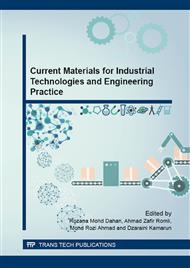[1]
A.N. Gent, and M. Hindi, Heat Build-up and Blowout of Rubber Blocks, Institute of Polymer Science & Polymer Engineering Center, University of Akron, Ohio. Presented at a meeting of Rubber Division, American Chemical Society, April 19, (1988).
DOI: 10.5254/1.3536225
Google Scholar
[2]
R.D. V Bennett, H. Ceato, G.J. Lake, R.M. Rollason, G.A. Pittman, Mechanism of heat buildup failure in tyres, Proc. 1975 International Rubber Conference, Kuala Lumpur, pp.191-210, (1975).
Google Scholar
[3]
R. Mukhopadhyay, Degradation in truck tyres under high temperature service conditions, Hari Shankar Singhania Elastomer & Tyre Research Institute, p.473, (2007).
Google Scholar
[4]
ASTM D623-07. Standard Test Methods for Rubber Property – Heat Generation and Flexing Fatigue in Compression.
DOI: 10.1520/d0623-99
Google Scholar
[5]
ISO 4666/3. Rubber vulcanized- Determination of temperature rise and resistance to fatigue in flexometer testing. Part 3; Compression Flexometer.
DOI: 10.3403/30184527u
Google Scholar
[6]
Eberhard Meinecke, Effect of Carbon Black Loading and Crosslink Density on Heat Build-up in Elastomers, Department of Polymer Science, University of Akron, Ohio. Presented at a meeting of Rubber Division, American Chemical Society, May 29 (1990).
DOI: 10.5254/1.3538558
Google Scholar
[7]
Marina Xanthos, Polymer and Polymer Composites', Functional Fillers for Plastics, September 26, (2005).
Google Scholar
[8]
Mohd Bijarimi, H. Zulkafli, and M.D. H Beg, Mechanical Properties of Industrial Tyre Rubber Compounds, Journal of Applied Sciences 10 (13) pp.1345-1348, (2010).
DOI: 10.3923/jas.2010.1345.1348
Google Scholar
[9]
Horst Deckmann, A Modern Universal Flexometer and a Dynamic Mechanic Thermal Spectrometer-Heat build-up and Viscoelastic data by One Test, Gabo Qualimeter Testanlagen GmbH, Schulstr. 6, 29693 Ahlden/Germany, pp.1-9, (2003).
Google Scholar
[10]
Mouri. H, A New Flexometer to Predict Heat Generation of Truck Tires, Tire Materials Development, Bridgestone Corporation, Tokyo, Japan. 148th Meeting of American Chemical Society, Division of Rubber Chemistry, (1995).
Google Scholar
[11]
ISO 4666/4. Rubber, Vulcanized – Determination of temperature rise and resistance to fatigue in flexometer testing – Part 4: Constant Stress Flexometer.
DOI: 10.3403/30113811u
Google Scholar
[12]
Rohaidah A. R, Ahmad Khairul M, Dayang Habibah A. I, Mohd Ismail Rifdi R., The Basic Physical Properties and Heat Build-Up of New TSR, SMR 20 and SMR20CV Vulcanisates, presented at 2013 National Symposium Polymeric Materials, Universiti Kuala Lumpur.
Google Scholar
[13]
Richard M. Schriver, Tyre with Tread of Selective Rubber Blends, U. S Patent 4894420, January 16, (1990).
Google Scholar
[14]
Lawrence E. Nielsen, Robert F. Landel, Mechanical Properties of Polymers and Composites, Second Edition, (1993).
Google Scholar
[15]
Gabo Qualimeter, Gabometer 2000 Application, Product Brochure, [Online]. Available: http: /www. gabo. com.
Google Scholar
[16]
Azemi bin Samsuri, Chapter 7; Introduction to Rubber Technology, An Introduction to Polymer Science and Rubber Technology, pp.117-154, (2009).
Google Scholar
[17]
Mohd Ismail Rifdi R., Evaluation of New Rubber Properties on Heat Build Up and Tan Delta for Truck Tyre Tread Application, MRB Technical Report (2011).
Google Scholar


